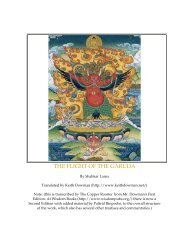Hiller - The Myth of Primitivism. Perspectives on Art - Esoteric Online
Hiller - The Myth of Primitivism. Perspectives on Art - Esoteric Online
Hiller - The Myth of Primitivism. Perspectives on Art - Esoteric Online
You also want an ePaper? Increase the reach of your titles
YUMPU automatically turns print PDFs into web optimized ePapers that Google loves.
<str<strong>on</strong>g>The</str<strong>on</strong>g> myth <str<strong>on</strong>g>of</str<strong>on</strong>g> primitivism 74<br />
that is indifferent to the total unity <str<strong>on</strong>g>of</str<strong>on</strong>g> man…. <str<strong>on</strong>g>The</str<strong>on</strong>g> subjective aura <str<strong>on</strong>g>of</str<strong>on</strong>g> the<br />
product also disappears in relati<strong>on</strong> to the c<strong>on</strong>sumer because the<br />
commodity is now produced independently <str<strong>on</strong>g>of</str<strong>on</strong>g> him. 21<br />
<str<strong>on</strong>g>The</str<strong>on</strong>g> search for authenticity, felt to be lacking in the art and life-style <str<strong>on</strong>g>of</str<strong>on</strong>g> their own times,<br />
guided the expressi<strong>on</strong>ists to the art <str<strong>on</strong>g>of</str<strong>on</strong>g> n<strong>on</strong>-European peoples. In 1906, when Nolde joined<br />
briefly the artistic circles gathered around the Folkwang Museum, he would have seen<br />
displayed in the Jugendstil interior Osthaus’s collecti<strong>on</strong> <str<strong>on</strong>g>of</str<strong>on</strong>g> modern European art<br />
al<strong>on</strong>gside n<strong>on</strong>-European art and artefacts. 22 Since the opening <str<strong>on</strong>g>of</str<strong>on</strong>g> the museum in 1902, the<br />
display <str<strong>on</strong>g>of</str<strong>on</strong>g> n<strong>on</strong>-European art, c<strong>on</strong>sisting mainly <str<strong>on</strong>g>of</str<strong>on</strong>g> oriental and Indian examples before<br />
1912, was presented to guide modern art and design with examples <str<strong>on</strong>g>of</str<strong>on</strong>g> ‘unalienated’<br />
artefacts. Osthaus’s commitment to Jugendstil involved a belief in reform and rebirth;<br />
and n<strong>on</strong>-European cultures seemed to <str<strong>on</strong>g>of</str<strong>on</strong>g>fer a model for a more ‘whole’ and integrated<br />
relati<strong>on</strong>ship between art and society. Such idealistic representati<strong>on</strong>s <str<strong>on</strong>g>of</str<strong>on</strong>g> n<strong>on</strong>-European<br />
societies had provided Europeans since the eighteenth century with a counter-image to<br />
the fractures and transform a-ti<strong>on</strong>s under way in the modern world, avoiding all<br />
discussi<strong>on</strong> about the realities <str<strong>on</strong>g>of</str<strong>on</strong>g> historical change wrought by col<strong>on</strong>ial exploitati<strong>on</strong>. As far<br />
as Nolde was c<strong>on</strong>cerned, the aesthetic display <str<strong>on</strong>g>of</str<strong>on</strong>g> n<strong>on</strong>-European art in the Folkwang<br />
Museum provided a welcome alternative to the ‘scientific’ criteria <str<strong>on</strong>g>of</str<strong>on</strong>g> the ethnographic<br />
museums, and this c<strong>on</strong>text for his early encounter with n<strong>on</strong>-European art guided the<br />
forms <str<strong>on</strong>g>of</str<strong>on</strong>g> his later interest. 23<br />
Although Nolde was aware <str<strong>on</strong>g>of</str<strong>on</strong>g> n<strong>on</strong>-European art by the early years <str<strong>on</strong>g>of</str<strong>on</strong>g> the century, it<br />
was not until 1911, following the Secessi<strong>on</strong> row, that he began to use tribal artefacts as a<br />
visual model. To some extent this was a sign <str<strong>on</strong>g>of</str<strong>on</strong>g> solidarity with the expressi<strong>on</strong>ist<br />
Secessi<strong>on</strong>, which asserted its identity through the use <str<strong>on</strong>g>of</str<strong>on</strong>g> primitivist references. As we<br />
have already observed, the splitting-<str<strong>on</strong>g>of</str<strong>on</strong>g>f <str<strong>on</strong>g>of</str<strong>on</strong>g> the old and new Secessi<strong>on</strong>s c<strong>on</strong>stituted a crisis<br />
within German modernism that we find reflected in the thematic alternatives in Nolde’s<br />
paintings <str<strong>on</strong>g>of</str<strong>on</strong>g> the period. In 1910 and 1911, Nolde c<strong>on</strong>tinued to work <strong>on</strong> his religious<br />
works, beginning in the summer <str<strong>on</strong>g>of</str<strong>on</strong>g> 1911 a series <str<strong>on</strong>g>of</str<strong>on</strong>g> paintings which he assembled into<br />
the nine-part polyptych <str<strong>on</strong>g>The</str<strong>on</strong>g> Life <str<strong>on</strong>g>of</str<strong>on</strong>g> Christ early in 1912. <str<strong>on</strong>g>The</str<strong>on</strong>g>se were the c<strong>on</strong>tinuati<strong>on</strong> <str<strong>on</strong>g>of</str<strong>on</strong>g><br />
the spiritual, inner directi<strong>on</strong> in Nolde’s work, and, coinciding in terms <str<strong>on</strong>g>of</str<strong>on</strong>g> subject if not<br />
style with aspects <str<strong>on</strong>g>of</str<strong>on</strong>g> c<strong>on</strong>servative, volkish ideology, they can be seen as his antidote to<br />
the fragmentati<strong>on</strong>s <str<strong>on</strong>g>of</str<strong>on</strong>g> modernity. 24 Nolde shared with the c<strong>on</strong>servative wing in the<br />
debates around nati<strong>on</strong>al identity and modernity, a deep-seated mistrust <str<strong>on</strong>g>of</str<strong>on</strong>g> change in the<br />
countryside: he fought against the introducti<strong>on</strong> <str<strong>on</strong>g>of</str<strong>on</strong>g> customs-houses, pumping stati<strong>on</strong>s, and<br />
dykes into the North Schleswig countryside, where he was born in 1867 and spent the<br />
summer m<strong>on</strong>ths <str<strong>on</strong>g>of</str<strong>on</strong>g> his working year. But his attitudes to the city did not fall into the<br />
classic c<strong>on</strong>servative mould, and he approached Berlin with mixed feelings <str<strong>on</strong>g>of</str<strong>on</strong>g> fascinati<strong>on</strong><br />
and distrust. 25 Since 1902, Nolde had spent the winter m<strong>on</strong>ths in Berlin, which provided<br />
important opportunities to learn about the internati<strong>on</strong>al modern movement and to make<br />
known his own art.<br />
C<strong>on</strong>current to his religious paintings, Nolde began a sec<strong>on</strong>d group <str<strong>on</strong>g>of</str<strong>on</strong>g> works. During<br />
the thick <str<strong>on</strong>g>of</str<strong>on</strong>g> the Secessi<strong>on</strong> row, as if to reassert his commitment to modernity, Nolde<br />
began a sustained series addressing the kaleidoscope <str<strong>on</strong>g>of</str<strong>on</strong>g> city life. In his drawings,<br />
graphics, and then paintings, we find scenes drawn from the cabaret, cafés, and theatre,<br />
favoured by other New Secessi<strong>on</strong> artists, and unique to this phase <str<strong>on</strong>g>of</str<strong>on</strong>g> Nolde’s oeuvre.




